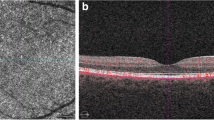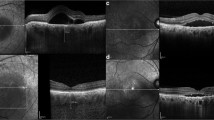Abstract
Central serous chorioretinopathy (CSCR) is characterized by neurosensory retinal detachment. Because the retina pigment epithelium and choroidal pathology is the current mechanism in CSCR, many studies in the literature focused on the outer retinal layers. There is little information about the functional or histological structure of the detached retina. In this study, we assess the ganglion cell complex (GCC) thickness using optical coherence tomography (OCT) in patients with acute and chronic CSCR. The medical records of 16 acute and 19 chronic CSCR patients which have no other disorders that cause a serous macula detachment were analyzed. Chronic cases were also divided into two subgroups: chronic active and chronic nonactive CSCR. The eyes with extramacular involvement or cystoid degeneration and cases which developed choroidal neovascularization were excluded from the study. The mean, minimum, superior-nasal, superior, superior-temporal, inferior-nasal, inferior, and inferior-temporal GCC values obtained using OCT were used for analysis. The duration from the onset was 7.8 ± 4.5 weeks and the mean age was 45.0 ± 10.7 years in acute CSCR, and in chronic cases the values were 36.0 ± 6.2 weeks and 52.9 ± 10.5 years, respectively. There were no significant differences in sex distribution. The chronic cases were statistically significantly older than acute cases (p = 0.02). While there was no difference between the acute and chronic cases, there were statistically significant differences between the chronic CSCR and control group in all values of GCC. Additionally, there were statistically significant differences between the acute CSCR and control group in mean, minimum, and superior-temporal GCC thicknesses. Although choroid and outer retinal layers play an important role in the pathogenesis of CSCR, there is scant information about the functional or histological structure of the detached retina in CSCR. Our results showed that GCC was significantly reduced in both acute and chronic CSCR compared to healthy subjects. Analysis of ganglion cell helps us understand the etiology of the patients which healed anatomically but had limited visual improvement in CSCR.



Similar content being viewed by others
References
Velthoven MEJ, Verbraak FD, Garcia PM et al (2005) Evaluation of central serous retinopathy with en face optical coherence tomography. Br J Ophthalmol 89:1483–1488
Caccavale A, Romanazzi F, Imparato M et al (2011) Central serous chorioretinopathy: a pathogenetic model. Clin Ophthalmol 5:239–243
Bouzas EA, Karadimas P, Pournaras CJ (2002) Central serous chorioretinopathy and glucocorticoids. Surv Ophthalmol 47:431–448
Norouzpour A, Abrishami M (2016) Central serous chorioretinopathy: from glucocorticoids to light intensity. Int J Ophthalmol 9:312–314
Gupta LY, Marmor MF (1996) Electrophysiology of the retinal pigment epithelium in central serous chorioretinopathy. Doc Ophthalmol 91:101–107
Hamzah F, Shinojima A, Mori R et al (2014) Choroidal thickness measurement by enhanced depth imaging and swept-source optical coherence tomography in central serous chorioretinopathy. BMC Ophthalmol 14:145
Yun C, Oh J, Han JY et al (2015) Peripapillary choroidal thickness in central serous chorioretinopathy: ıs choroid outside the macula also thick? Retina 35(9):1860–1866
Goktas A (2014) Correlation of subretinal fluid volume with choroidal thickness and macular volume in acute central serous chorioretinopathy. Eye (Lond) 28:1431–1436
Carrai P, Pichi F, Bonsignore F et al (2015) Wide-field spectral domain-optical coherence tomography in central serous chorioretinopathy. Int Ophthalmol 35:167–171
Teke MY, Elgin U, Nalcacioglu-Yuksekkaya P et al (2014) Comparison of autofluorescence and optical coherence tomography findings in acute and chronic central serous chorioretinopathy. Int J Ophthalmol 7:350–354
Kim YY, Flaxel CJ (2011) Factors influencing the visual acuity of chronic central serous chorioretinopathy. Korean J Ophthalmol 25:90–97
Spaide RF, Goldbaum M, Wong DW et al (2003) Serous detachment of the retina. Retina 23:820–846
Negi A, Marmor MF (1984) Experimental serous retinal detachment and focal pigment epithelial damage. Arch Ophthalmol 102:445–449
Spitznas M, Huke J (1987) Number, shape and topography of leakage points in acute type I central serous retinopathy. Graefes Arch Clin Exp Ophtahlmol. 225:437–440
Iida T, Spaide RF, Haas A et al (2002) Leopard spot pattern of yellowish subretinal deposits in central serous chorioretinopathy. Arch Ophthalmol 120:37–42
Iijima H, Iida T, Murayama K et al (1999) Plasminogen activator inhibitor 1 in central serous chorioretinopathy. Am J Ophthalmol 127:477–478
Matsuma H, Kishi S, Sato T et al (2011) Fundus autofluorescence of elongated photoreceptor outer segments in central serous chorioretinopathy. Am J Ophthalmol 151:617–623
Piccolino FC, De La Longrais RR, Ravera G et al (2005) The foveal photoreceptor layer and visual acuity loss in central serous chorioretinopathy. Am J Ophthalmol 139:87–99
Demirok G, Gul A, Turacli E et al (2015) Choroidal and ganglion cell complex thicknesses in subjects with Type A behavior pattern: an optical coherence tomography study. JCAM. doi:10.4328/JCAM.3253
Medeiros FA, Zangwill LM, Anderson DR et al (2012) Estimating the rate of retinal ganglion cell loss in glaucoma. Am J Ophthalmol 154:814–824
Tewari HK, Gadia R, Kumar D et al (2006) Sympathetic-parasympathetic activity and reactivity in central serous chorioretinopathy: a case-control study. Invest Ophth Vis Sci 47:3474–3478
Haimovici R, Rumelt S, Melby J (2003) Endocrine abnormalities in patients with central serous chorioretinopathy. Ophthalmology 110:698–703
Jampol LM, Weinreb R, Yannuzzi L (2002) Involvement of corticosteroids and catecholamines in the pathogenesis of central serous chorioretinopathy: a rationale for new treatment strategies. Ophthalmology 109:1765–1766
Gruszka A (2013) Potential involvement of mineralocorticoid receptor activation in the pathogenesis of central serous chorioretinopathy: case report. Eur Rev Med Pharmacol Sci 17:1369–1373
Akyol M, Erol MK, Ozdemir O et al (2015) A novel mutation of sgk-1 gene in central serous chorioretinopathy. Int J Ophthalmol 18:23–28
Ichiseki T, Maatsumoto T, Nishino M et al (2004) Oxidative stress and vascular permeability in steroid-induced osteonecrosis model. J Orthop Sci 9:509–515
Chandra P, Sudhalkar A, Mandal S et al (2015) Retinal circulation and its role in macular disorders in patients without systemic disease. Int J Ophtalmol 8:585–589
Author information
Authors and Affiliations
Corresponding author
Ethics declarations
Conflict of interest
The authors report no conflict of interest in this work.
Rights and permissions
About this article
Cite this article
Demirok, G., Kocamaz, F., Topalak, Y. et al. Macular ganglion cell complex thickness in acute and chronic central serous chorioretinopathy. Int Ophthalmol 37, 409–416 (2017). https://doi.org/10.1007/s10792-016-0278-4
Received:
Accepted:
Published:
Issue Date:
DOI: https://doi.org/10.1007/s10792-016-0278-4




